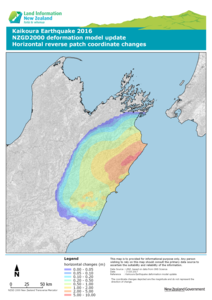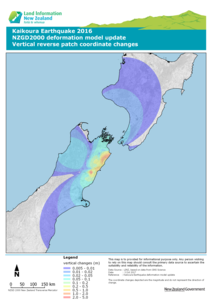A new version of NZGD2000 (version 20171201) was released on 14 January 2018. The deformation model in this version includes "patches" for the movement due to the Kaikoura earthquake of 14 November 2016 and subsequent post-seismic deformation. As a result NZGD2000 coordinates have been changed in the area most affected by the earthquakes.
The updated datasets were made available within LINZ Data Service and the streamed PositioNZ-RT coordinates were updated.
The change was implemented in Landonline by applying a reverse patch to the deformation model used within NZGD2000. This changed the NZGD2000 coordinates of features in the affected area.
Horizontal coordinate changes are up to 6 metres, though most are much less. These changes also affect coordinates based on NZGD2000, such as NZTM2000 coordinates and the meridional circuit coordinates used by surveyors. Height coordinates were also updated where the change was significant. Heights in terms of tide gauge based local vertical datums were updated as well as those based on New Zealand Vertical Datum 2016 (NZVD2016).
The coordinate changes were applied to features in the Landonline survey and title database - approximately 72700 parcels have been updated. These changes will be reflected in the LINZ Data Service spatial data layers which are derived from Landonline.
LINZ is also providing NTv2 grids that can be used to apply the update to coordinates in GIS databases to keep them aligned with NZGD2000.
Survey control points close to the area of faulting have had their orders downgraded, as the deformation model cannot accurately determine the movements near the faults. At the same time the coordinates of control points which have been resurveyed since the earthquake were updated to support on-going survey work.
The vertical changes reflect the actual ground movement as a result of the earthquake. However the horizontal coordinate changes do not include all the actual ground movement. Instead the changes are restricted to a smaller affected area in order to reduce the impact on GIS databases. The movement not included in the coordinate update is accommodated by a forward patch that is included in the revised NZGD2000 deformation model. For information about the difference between a forward and a reverse patch please refer to NZGD2000 Deformation Model.
Email customersupport@linz.govt.nz if you have any questions or would like to receive more information.

NZGD2000 deformation model update - horizontal reverse patch coordinate changes

NZGD2000 deformation model update - vertical reverse patch coordinate changes
Why are the horizontal and vertical update areas different?
LINZ is implementing a hybrid patch to the deformation model, this includes components of a reverse and forward patch. Coordinates in the affected area will have movements accounted for by the reverse patch and some movement absorbed by the forward patch. Actual horizontal movement outside the update area will not be applied to the NZGD2000 coordinates. The movements will be accounted for or absorbed by forward patch component of the update to the deformation model.
Land movement maps show actual movements caused by the Kaikoura Earthquake.
It is important that NZVD2016 continues to reflect actual elevation and height differences. Critical infrastructure such as sewerage and water reticulation need to designed and laid out using heighting information that reflects reality.
What tools are available to update my spatial database?
If you wish to update your spatial database LINZ will be providing some transformations tools. NTv2 grids can be used to adjust the coordinates in GIS databases to keep them aligned with NZGD2000 and NZTM2000.
This following links provide information applying the update within ESRI and open source product.
How will the update affect NZVD2016 heights and local vertical datum heights?
All NZVD2016 heights in the affected area have been recalculated and updated to reflect the ground movement as a result of the earthquakes, except where the change is insignificant to the accuracy of the height. Where the model is poorly known, for example near fault ruptures, height orders have been downgraded to reflect this. Most NZVD2016 heights have also been updated using the national geodetic adjustment which includes post-earthquake data. Historical height values are available in the online geodetic database.
Similarly, LINZ has applied the vertical deformation model update to local vertical datum heights even though there has been no new levelling. This approach has been taken to provide the best estimate of the current relative positions of heights rather than to maintain historic values which are known to be inaccurate. However the national geodetic adjustment coordinates do not apply to the local vertical datum coordinates.
The NZGeoid2016 grid and vertical datum transformation grids for each of these vertical datums remain unchanged.